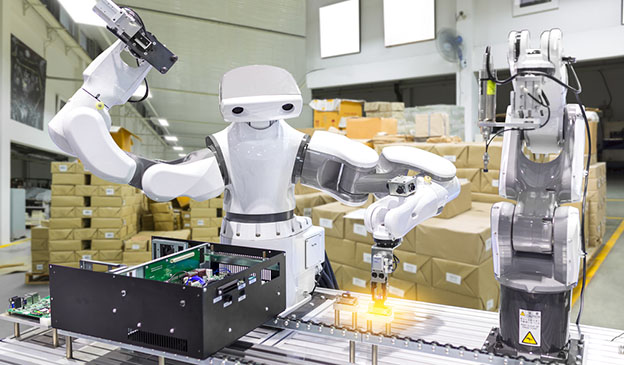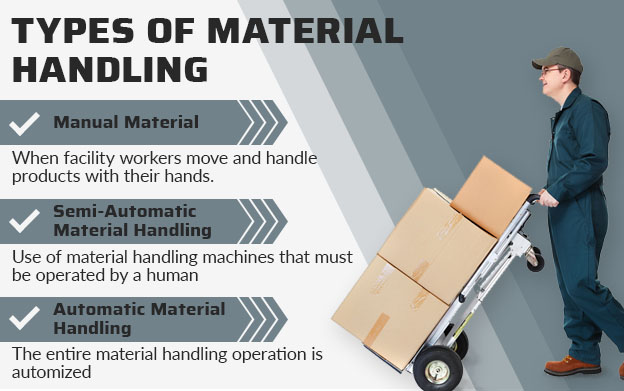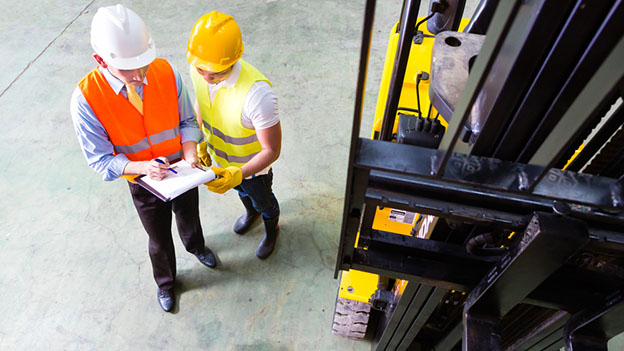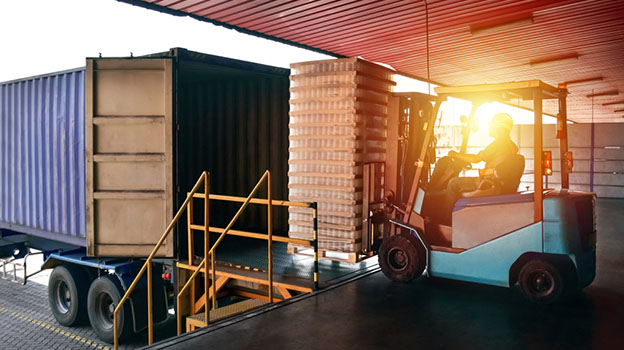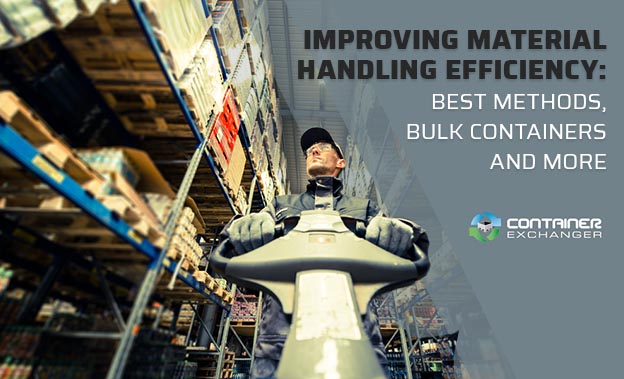 As the eCommerce industry continues to change the way businesses move and ship products around the world, material handling has changed dramatically over the last few years. Businesses and manufacturers need to move their products within a facility or between the facility and a transportation vehicle as quickly and as safely as possible if they want to succeed in today’s economy. Improving material handling efficiency can also improve workplace safety, lower overhead expenses and improve customer service and loyalty.
As the eCommerce industry continues to change the way businesses move and ship products around the world, material handling has changed dramatically over the last few years. Businesses and manufacturers need to move their products within a facility or between the facility and a transportation vehicle as quickly and as safely as possible if they want to succeed in today’s economy. Improving material handling efficiency can also improve workplace safety, lower overhead expenses and improve customer service and loyalty.
The materials handling market is expected to be worth more than $190 billion by 2024. To speed up the material handling process, many businesses are starting to invest in automated solutions, material handling systems and the Internet of Things (IoT). Yet, there is no one-size-fits-all approach to improving material handling efficiency. Any effort to improve efficiency should be tailored to the facility’s unique needs and workflow.
If you own or manage a warehousing or manufacturing facility, learn more about this important topic and how technology is changing material handling for the better.
What Is Material Handling?
Material handling is the process of moving materials, including products and raw materials, within a warehousing or manufacturing facility or between a facility and a transportation vehicle. In addition to the movement of these goods and products, material handling also encompasses the storage, protection and control of these items. If an item is damaged throughout this process, it will affect your overall output, so it’s important to maintain safe storage and handling conditions in addition to efficient transportation practices.
Different Types of Material Handling
Material handling falls into one of three categories, including manual, semi-automatic and automatic. Every category comes with its own considerations and best practices. Understanding the differences between these categories will help you find the right material handling solutions for your facility.
Manual Material Handling
Manual material handling is when facility workers move and handle products with their hands. They will typically lift, sort and carry products throughout the facility and between the facility and the transportation vehicle. This style of material handling is more common among smaller, independent facilities.
Over time, manual material handling can lead to a higher rate of workplace injuries. According to the National Safety Council, overexertion, including lifting, lowering and repetitive motions, accounts for 33.5 percent of workplace injuries. Contact with objects and equipment account for 26 percent of workplace injuries. Workers may also get injured walking across the facility floor. Slips, trips and falls account for 25.8 percent of workplace injuries.
Semi-Automatic Material Handling
Semi-automatic material handling refers to the use of material handling machines that must be operated by a human, such as mechanical lift trucks, conveyor belts and packing equipment. While human workers still make up the bulk of material handling processes, workers aren’t responsible for moving these objects by hand, which can help prevent the number of workplace injuries such as sprains, muscle cramps and aches and lower back problems.
Automatic Material Handling
Automatic material handling means the entire material handling operation is automized. Machines such as automatic pickers and stockers, packaging systems and self-driving lift trucks are responsible for the movement and handling of individual items. Workers may supervise these operations, but they are not driving or handling the equipment themselves.
Why Material Handling Efficiency Is Important
With the material handling sector on the rise, your facility needs to optimize efficiency as much as possible in order to stay competitive. If your facility mishandles products and materials, it will damage your reputation in the industry. Delayed or disorganized shipments will impair your ability to serve your customers. A messy or unsafe facility will also put your workers at risk, increasing the chances of workplace accidents and potential lawsuits.
The benefits of improving material handling efficiency include:
- Improved customer service
- Lower overhead expenses
- Improved ergonomics and worker safety
- Fewer order fulfillment errors
- Increased capacity and revenue
Improving your material handling processes is an important part of facility management. Your workers depend on you when it comes to improving workplace conditions and speeding up the order fulfillment process. With the right modifications, your employees can use their time more efficiently without overexerting themselves or putting themselves or their colleagues at risk.
Tips for Improving Material Handling
Analyze Your Current Operations
The first step toward improving material handling efficiency is taking stock of your current operations. You can’t improve your approach to material handling without first understanding how products and materials move throughout your facility and the obstacles that prevent you and your team from reaching optimal efficiency.
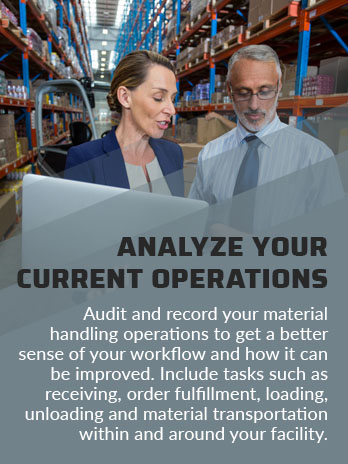 Audit and record your material handling operations to get a better sense of your workflow and how it can be improved. This should include tasks such as receiving, order fulfillment, loading, unloading and material transportation within and around your facility. You should also record the unit load, the overall weight and size of a single unit. If your team is handling or transporting multiple items at once, the unit load would encompass all the items included in the shipment. You should determine the weight, size, configuration and type of unit loads moving through your facility as well as the time and effort required to complete each task or trip.
Audit and record your material handling operations to get a better sense of your workflow and how it can be improved. This should include tasks such as receiving, order fulfillment, loading, unloading and material transportation within and around your facility. You should also record the unit load, the overall weight and size of a single unit. If your team is handling or transporting multiple items at once, the unit load would encompass all the items included in the shipment. You should determine the weight, size, configuration and type of unit loads moving through your facility as well as the time and effort required to complete each task or trip.
Once you have this information, you can start creating a list of key performance indicators (KPIs), such as your overall output, customer satisfaction levels, the amount of time required to fulfill orders, load and unload vehicles or even worker turnaround. Focus on these KPIs when making changes to your material handling process and use them to measure the success of these changes.
Assign Tasks Based on Experience Level
Instead of indiscriminately assigning tasks to your workers, utilize the strengths of your team members when divvying up individual tasks. Your most experienced employees will be better at sorting and receiving products than new workers, considering they will be more familiar with your products and the layout of your facility.
New employees will be better off retrieving items from the shelf and fulfilling orders. This helps them familiarize themselves with your products and how they’re stored throughout your facility. This also makes it easier to schedule the workday. New employees can fulfill orders as they come in until they understand the inner workings of your facility. If an employee has trouble driving and handling certain pieces of equipment, leave these tasks to other team members.
Assigning tasks based on proficiency also reduces confusion in the workplace. Your team members will always know what’s expected of them and how they should be using their time.
Consider Ergonomic Limitations
If you rely on manual material handling, one of the biggest obstacles you’ll face in the workplace is the physical limitations of your workers. Even in the absence of workplace injuries, your workers will become fatigued throughout the day as they lift, squat, carry and bend over again and again. Fatigue can also lead to costly errors, such as damaged inventory, incorrect orders and workplace accidents.
To get a better sense of the ergonomics of your workplace, talk to your workers about the physical demands of the job and how they can be improved. To reduce fatigue, have your workers take more breaks throughout the day but for shorter periods of time. Teach them the proper way to lift objects and shipping containers to avoid physical injuries. Your workers should avoid bending, reaching or twisting when lifting.
You can also invest in automatic or semi-automatic material handling equipment, such as lift trucks, carts and pickers and stockers to improve the ergonomics of your workplace.
Focus on One Task at a Time
You can also increase material handling efficiency by having your workers focus on one aspect of your operations at a time instead of having them do everything at once. For example, you and your team can devote the first half of the day to order fulfillment, while the second half of the day will involve unloading new shipments, product sorting and reorganizing the layout of the facility.
Choosing which tasks to focus on and when all depends on the nature and schedule of your facility. If orders need to go out in the morning, this should be your first priority. Organizing and storing new products can wait until the afternoon or evening.
Space Out Deliveries and Drop-Offs
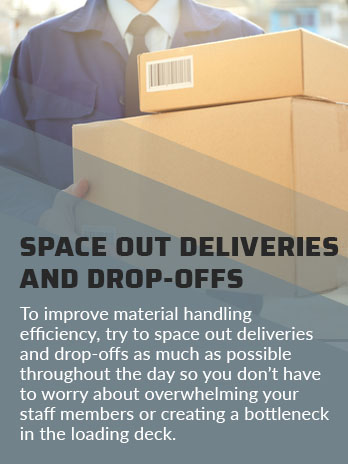
To improve material handling efficiency, try to space out these urgent tasks as much as possible throughout the day so you don’t have to worry about overwhelming your staff members or creating a bottleneck in the loading deck. If you can schedule deliveries and drop-offs, come up with a strategy that works for you and your team.
Simplify Loading/Unloading with Bulk Containers
Recording the unit load of your products and shipments will help you better anticipate the needs of your workers. But increasing the unit load can help you reduce the number of trips that need to be completed in and around your warehouse facility. Utilize space-saving storage bins to transport multiple items and containers at once so you don’t have to waste time making multiple trips. Use these bins when loading and unloading your transportation vehicles, organizing and sorting products or to stage products before they go out for delivery.
When using bulk containers for shipping, storage or transportation, pack these containers until they’re full to limit the amount of movement during transportation or some of your items may get damaged in the process. As you increase the unit load, use lift trucks to avoid overexerting your employees if the total weight exceeds their physical limitations.
Maintain Your Warehouse or Storage Facility
Keeping your warehouse or storage facility organized will help you improve material handling efficiency and the overall health and safety of your employees. Keep aisles and pathways clear to ease the flow of products and materials. Your employees should be able to move or drive through these spaces without worry about tripping over miscellaneous items or running into equipment and merchandise. These spaces should also be well lit, so your employees can make their way through the facility without hurting themselves. Use proper signage and product labels so your employees can quickly find what they need.
You should get in the habit of reorganizing your facility at the end of each shift or workday, making the space ready for the morning. Teach your employees the importance of keeping the space organized. Have them return products and equipment to the right place instead of leaving items in different locations.
Invest in a Material Handling Management System
You should also consider investing in a material handling management system, which helps you keep track of how products move throughout your facility. This is especially important if you own or manage a larger facility with thousands of different SKUs. Scanning products as they move throughout your facility or using smart scales and packaging equipment will automatically log transportation and order fulfillment times, which makes it easy to monitor material handling efficiency. You can then use this information to monitor and improve your operations.
Making Moves Towards Better Material Handling Practices
The methods used to improve material handling efficiency vary from facility to facility. It’s all about understanding the unique needs and concerns of your business and employees. Analyze your current processes before making changes to your workflow. Keep track of your KPIs before and after implementing these changes to make sure they’re improving material handling efficiency.
From bulk storage containers to automation and material handling management software, experiment with different material handling strategies until you find the best practices for warehouse organization.
